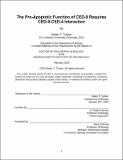The Pro-Apoptotic Function of CED-9 Requires a CED-9-CED-4 Interaction
Author(s)
Tucker, Nolan T.
DownloadThesis PDF (4.929Mb)
Advisor
Horvitz, H. Robert
Terms of use
Metadata
Show full item recordAbstract
Apoptosis is a fundamental, conserved process of cell death required for animal development and tissue homeostasis. In Caenorhabditis elegans apoptosis is inhibited by the BCL-2 homolog CED-9. In addition to its canonical anti-apoptotic role, CED-9 possesses an apparent proapoptotic function, because reduction in CED-9 function can result in decreased cell death – e.g., a ced-9(lf) allele enhances the partial cell-death defect of animals with a weak loss-of-function mutation in the pro-apoptotic caspase gene ced-3. This proapoptotic function of ced-9 is poorly understood. CED-9 has been thought to inhibit apoptosis by binding to and inhibiting the pro-apoptotic protein CED-4, the C. elegans homolog of APAF-1. In this work we show that mutations in either CED-9 or CED-4 located in their CED-9-CED-4 binding regions as defined by X-ray crystallography cause a defect in executing apoptosis without affecting the anti-apoptotic function of ced-9. We further show that these mutant CED-9 and CED-4 proteins are defective in a CED-9-CED-4 interaction in vivo. These data indicate that the known in vivo CED-9CED-4 interaction is required for the pro-apoptotic function of ced-9 but is dispensable for its anti-apoptotic function. While caspase-mediated apoptosis is the best characterized form of programmed cell elimination, other conserved mechanisms, such as cell extrusion, also exist. In C. elegans, at least eight cells that normally die by apoptosis are eliminated by cell extrusion in the absence of apoptosis. From an EMS mutagenesis screen, performed on worms lacking caspase activity, searching for survival of an extruded cell (ABplpappap), I isolated a nonsense mutation in the GMP reductase gene, gmpr-1. Interestingly, this allele (n6457) also allows ABplpappap to escape caspase-mediated apoptosis. Additionally, I found that RNAi against genes that affect either pyrimidine metabolism (pyr-1) or purine metabolism (gmpr-1 and adss-1) similarly allows ABplpappap to survive but that RNAi against R151.2, which affects both purine and pyrimidine metabolism, does not. gmpr-1(n6457) is suppressed by RNAi against R151.2 or pyr-1 but not by RNAi against the purine metabolism gene adss-1. These results suggest that the ability to maintain a normal physiologic ratio of purines and pyrimidines plays a role in cell extrusion and possibly in apoptosis as well. Given the highly conserved nature of cell-death genes and processes, interactions between human CED-9/BCL-2 family members and APAF-1 as well as nucleotide imbalance might play important roles in human diseases that involve disruptions in apoptosis, such as certain neurodegenerative disorders and cancers.
Date issued
2024-02Department
Massachusetts Institute of Technology. Department of BiologyPublisher
Massachusetts Institute of Technology